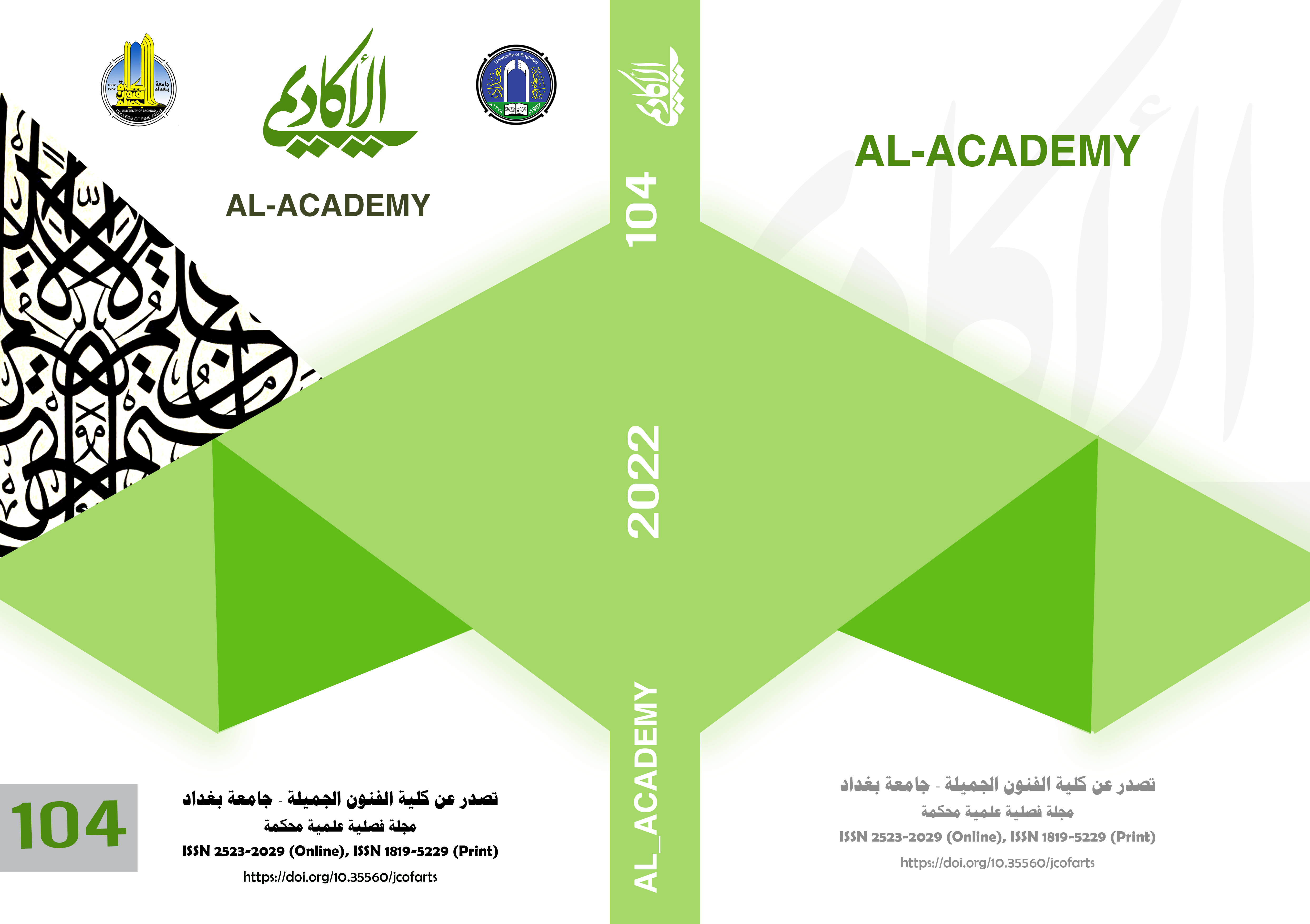The aesthetics of the symbol in the Iraqi theater scene
DOI:
https://doi.org/10.35560/jcofarts104/115-136Keywords:
Philosophy of theatrical arts, theatrical theoristAbstract
Theatrical performances began with the Greeks when the theatrical scenes and skeletal figures were encoded, where the large wall of the Alskina, which contains three doors, the middle of them with a high height, and the two sides took the natural size, where the middle door indicated a symbolism of the god or demigods, as we find the condensation of the symbol in the architecture of the theater, and the symbol was taken In the theatrical scene, the development semantically and aesthetically, and interpreting and interpreting the current day, where the laser light formed the symbolism of the contemporary virtual scene, and in order to identify the aesthetics of the symbol in the theatrical scene, the current research was evaluated into four chapters: The first chapter (the methodological framework) which contained the research problem that The question was (What are the aesthetics of the symbol in the Iraqi theatrical appearance?) The aim of the research was (to identify the aesthetics of the symbol in the Iraqi theatrical scene). As for the second chapter (the theoretical framework), it was divided into sections: The first topic: the aesthetic manifestations of the symbol / the second topic: the use of the symbol in the aesthetic theatrical scene. The third chapter came (research procedures), (research community/research sample) (presentation of the picnic play, and research methods (descriptive and analytical), while the fourth chapter contained the research results and conclusions and concluded the research with a list of sources
References
Abdel Nour, J. (1973). Literary Dictionary. Beirut: Dar Al-Ilm for Millions.
Ador, O. (1996). The Art of Representation, Horizons and Depths. Cairo: Center for Languages and Translation, Cairo Experimental Festival.
Al-Bahili, R. (2010). The semiotics of light movement in theatrical performance, , 2010. Baghdad: Al-Academy Journal , College of Fine Arts, University of Baghdad, No. 53.
Al-Kawaz, I. (2004). Aesthetics of the view in the open spaces of Iraqi theater performances, Master's thesis. Baghdad: College of Fine Arts, University of Baghdad.
Al-Kubaisi, T. (2000). The Aesthetics of Artistic Arabic Prose, The Small Encyclopedia. Baghdad: House of General Cultural Affairs.
Alloush, S. (1985). A Dictionary of Contemporary Literary Terms. Beirut: Lebanese Book House.
Al-Mousa, M. (2004). Scenography between the Middle Ages and the Renaissance. Iraq: Ofoq Magazine, p. 48, Culture Foundation,.
Al-Rawi, A.-T. (B.T). Arranging the Ocean Dictionary. Cairo: Mut'a Issa Al-Babi.
Al-Tikriti, d.-N. (1996). Employing theatrical decoration for foreign performances in the theater forum. Baghdad: Al-Academy Journal , College of Fine Arts, University of Baghdad, No. 13.
Al-Waeli, S. (2010). Symbolism and its formal uses in furniture designs for static spaces. Baghdad: Al-Academy Journal , College of Fine Arts, University of Baghdad, No. 56.
alyasuei, a. (1956). Al-Munajjid in Literature and Science. Beirut: Catholic Press.
Attia, A. (1996). Contradictions and Concordances in the Creativity of Theatrical Director (AIBA - Craig). Baghdad: Al-Academy Journal , College of Fine Arts, University of Baghdad, No. 5.
Attia, M. (2010). Art and Beauty in the Renaissance. Cairo: World of Books.
aykal. (1978). Symbolic Art. (G. Trabish, Trans.) Beirut: Printing House.
Corniche, A. (1997). Prague semiotics for theatre. Damascus: Ministry of Culture.
Craig, C. (1960). On theatrical art. (D. Khashabah, Trans.) Cairo: Library of Literature.
Crocini, F. (1999). Theater Space. (A. Fawzy, Trans.) Cairo: Ministry of Public Culture, Press of the Supreme Council of Antiquities.
Eid, K. (1997). A Scenography of Theater Through the Ages. Cairo: Dar Al Thaqafa Publishing.
Henry, B. (1981). Symbolic Literature. (H. Zughaib, Trans.) Beirut: Oweidat.
hiwaytnk, f. (1970). Introduction to theatrical arts. (K. Y. others, Trans.) Cairo: Dar Al Maaref.
Ibn Hanbal, I. (1969). The Musnad of Imam Ibn Hanba. Cairo: Curriculum House.
Ibn Manzoor, M.-F. (1956). Lisan Al-Arab. Beirut: Dar Al-Lisan Al-Arab.
Jaafar, A. (1996). Surveying technique and its role in developing theatrical performance from the Greek to the Renaissance. Baghdad: Al-Academy Journal , College of Fine Arts, University of Baghdad, No. 14.
Jaafar, A. (1996). Surveying technology and its role in the development of theatrical performance from the Greeks until the Renaissance. Iraq: Al-Akady magazine , No. 14.
John, D. (1946). The Art of play production New York Harptey Bvothevs, . New York: Harptey Bvothevs.
Johnson, R. (1978). Al-Gamaliya, Encyclopedia of Critical Terminology. (A. W. Lulua, Trans.) Baghdad: Publications of the Ministry of Culture and Arts.
Langer, S. (1986). The Philosophy of Art according to Susan Langer. (R. Hakim, Trans.) Baghdad: House of Public Cultural Affairs.
Mandour, M. (1974). Literature and its Doctrines. Cairo: Dar Al-Nahda.
Saliha, N. (1997). Contemporary Theatrical Currents. Cairo: The General Egyptian Book Organization, The Egyptian Authority Press.
Sfield, A. (1981). School of the Spectator. (S. Jamil, Trans.) Cairo: Experimental Theater Festival.
Wahba, M. (1974). A Dictionary of Literary Terms. Beirut: Library of Lebanon.
Wasfi, A. (2000). Cultural Anthropology. Damascus: Alaa El-Din House.
Young, C. (1984). Man and His Symbols. (S. Lane, Trans.) Baghdad: House of Cultural Affairs.
Downloads
Published
Issue
Section
License
Copyright (c) 2022 mothana mohammed Sharif

This work is licensed under a Creative Commons Attribution 4.0 International License.













